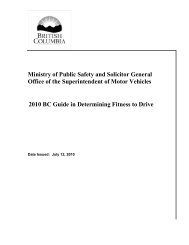Community Accountability Programs Information ... - Ministry of Justice
Community Accountability Programs Information ... - Ministry of Justice
Community Accountability Programs Information ... - Ministry of Justice
- No tags were found...
Create successful ePaper yourself
Turn your PDF publications into a flip-book with our unique Google optimized e-Paper software.
• If a young person is dealt with by an extrajudicial sanction, a police<strong>of</strong>ficer, the Attorney General, the provincial director, or anyorganization established by a province to provide assistance to victimsshall, on request, inform the victim <strong>of</strong> the identity <strong>of</strong> the young personand how the <strong>of</strong>fence has been dealt with.Under the Criminal Code, victims <strong>of</strong> crime are entitled to submit victimimpact statements to the court during the sentencing phase. These impactstatements describe “the harm done to, or loss suffered by, the victimarising from the commission <strong>of</strong> the <strong>of</strong>fence.” When determining theappropriate sentence for an <strong>of</strong>fender, the court is required to consider thesestatements. The victim may also read this statement in court (uponrequest) or present it in any other manner the court considers appropriate.It is worth noting that under the Criminal Code, the term “victim” refers to“a person to whom harm was done or who suffered physical or emotionalloss as a result <strong>of</strong> the commission <strong>of</strong> the <strong>of</strong>fence.” If that person is dead, ill,or otherwise incapable <strong>of</strong> making an impact statement, he or she may berepresented by a spouse or common-law partner, a relative, or anyone whohas custody <strong>of</strong> that person or is responsible for the care or support <strong>of</strong> thatperson or any dependant <strong>of</strong> that person.The Criminal Code recognizes the victim’s right to restitution as well as toan acknowledgment, by the <strong>of</strong>fender, <strong>of</strong> the harm that he or she has causedthe victim. In fact, Section 718 <strong>of</strong> the Criminal Code states that theobjectives <strong>of</strong> sentencing include the following: “to provide reparations forharm done to victims or to the community” and “to promote a sense <strong>of</strong>responsibility in <strong>of</strong>fenders, and acknowledgment <strong>of</strong> the harm done tovictims and to the community.”The Victims <strong>of</strong> Crime Act and documents listing references to victims in theYouth Criminal <strong>Justice</strong> Act and the Criminal Code are included inAppendices B, C, and D, respectively.Dynamics <strong>of</strong> victimization<strong>Community</strong> <strong>Accountability</strong> <strong>Programs</strong> can help victims recover from theharm caused by crime. However, to work effectively with victims, programvolunteers must understand the impact <strong>of</strong> crime, the factors that affect theintensity and duration <strong>of</strong> that impact, and the needs that victimsexperience.Guidelines for Working with Victims and Offenders 19
















